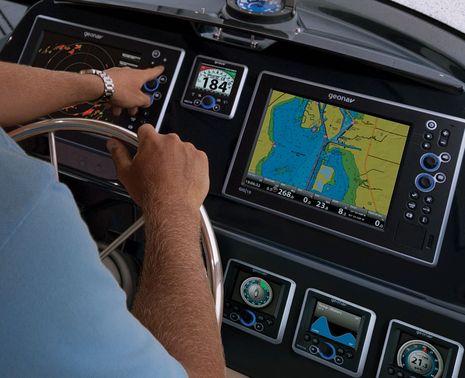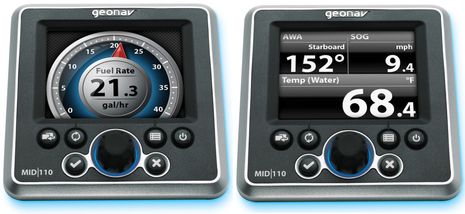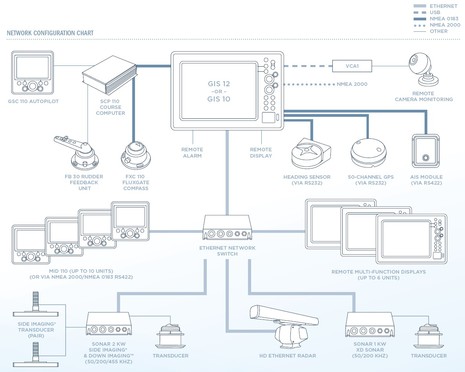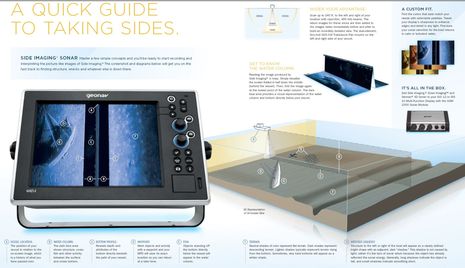Geonav, the giant roll out

Geonav has been talking about a Fall U.S. roll out for some time, but now it's turning out they have a lot more to show than the G12 and G10 MFDs introduced in Europe last year. Seen in the photo above is an even newer model called the GIS10, and while it and the 12-inch model include most all the features seen online for the G series, they also support NMEA 2000, Gigabit Ethernet, and, yes, the Side Imaging technology pioneered by sister company Humminbird. And how about those sexy MID 110 multifunction instrument displays (and the matching autopilot head)?
I have a draft copy of a large Geonav product brochure that should be printing soon, along with some closeups of those MIDs, and though they may be photo-shopped a bit, this sure looks like an interesting do-it-all display design. Check out the six-button-and-knob controls, for instance, and be surprised by the data ports on the back: NMEA 0183, NMEA 2000, and Ethernet... Geonav is not yet saying why you might want to use Ethernet instead of NMEA 2000, as in the system diagram below, but I'm surely curious. The diagram also illustrates how the GIS 10 and 12 use blackbox Side Imaging and Sonar, whereas the G 10 and 12 have Sonar built in. And the brochure's screen images, some available at Geonav, suggest that there's an interesting human interface at work here. As best I can tell, few people have had much experience with this interface yet because the G 10 and 12 didn't get shipped when originally planned. But I'm told that the production lines are now rolling down in Alabama (yes, though Geonav was originally an Italian company, the new MFDs may be the only ones built in the USA)...
Geonav is not yet saying why you might want to use Ethernet instead of NMEA 2000, as in the system diagram below, but I'm surely curious. The diagram also illustrates how the GIS 10 and 12 use blackbox Side Imaging and Sonar, whereas the G 10 and 12 have Sonar built in. And the brochure's screen images, some available at Geonav, suggest that there's an interesting human interface at work here. As best I can tell, few people have had much experience with this interface yet because the G 10 and 12 didn't get shipped when originally planned. But I'm told that the production lines are now rolling down in Alabama (yes, though Geonav was originally an Italian company, the new MFDs may be the only ones built in the USA)... I also think the brochure's graphic explanation of Side Imaging is the best I've seen yet, though after spending the summer with NSE StructureScan on Gizmo, I think a cruiser or fisherman can pick up the nuance, and value, of this technology fairly easily. At any rate, I think it's great that there are about to be two bigger boat systems that offer detailed side viewing (even if Humminbird and Geonav are still a little miffed about it.) And I'm certainly looking forward to Geonav's big roll out to the industry at the NMEA Conference next week, and to the public at Fort Lauderdale a few weeks later. I'll report on what I see, and also try to let you know when the new new stuff goes up on the Geonav Site.
I also think the brochure's graphic explanation of Side Imaging is the best I've seen yet, though after spending the summer with NSE StructureScan on Gizmo, I think a cruiser or fisherman can pick up the nuance, and value, of this technology fairly easily. At any rate, I think it's great that there are about to be two bigger boat systems that offer detailed side viewing (even if Humminbird and Geonav are still a little miffed about it.) And I'm certainly looking forward to Geonav's big roll out to the industry at the NMEA Conference next week, and to the public at Fort Lauderdale a few weeks later. I'll report on what I see, and also try to let you know when the new new stuff goes up on the Geonav Site.

 Share
Share
"Geonav is not yet saying why you might want to use Ethernet instead of NMEA 2000" - hopefully the answer to that is simply that they will be embracing OPEN standards instead of closed and proprietary databuses. If Geonav publishes their protocols, and makes them open, and freely available, they could win.